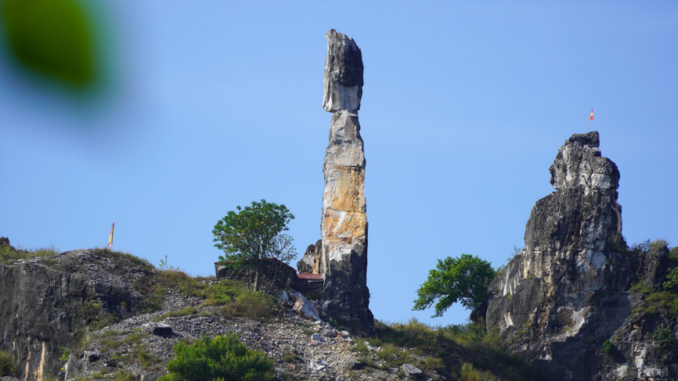
THANH HOA – Quan Thanh Temple is built on a craggy cliff, carved many reliefs, carved ancient Chinese characters … attracting tourists on the full moon day, the beginning of the month or Tet holidays.

Quan Thanh Temple is located on the eastern slope of An Hoach mountain range (An Hung ward, Thanh Hoa city). According to the inscription, the temple was built in the late 17th century under Le Trung Hung’s reign. In the 18th century, the temple was repaired by Duke Le Trung Nghia, allowing more statues to be carved on the cliffs or caves.

On a steep cliff outside the entrance to the temple, there is a large word “God” carved at a height of about 20 m. Right above the word God is an ancient bronze bell, weighing about 60-70 kg. Elders around the area do not know when the bell was cast and how it was hung on the steep mountainside. The bell is currently inactive, lying exposed and still quite intact, the surface is a bit rusty.

The portrait of Duke Le Trung Nghia with a square face in military uniform is also carved next to the road to the temple…

On the cliffs at the front and rear doors of the temple are carved many statues of elephants, stone horses and some mandarins or eunuchs standing next to them.

In particular, in the cave, there is a relief about 2.5 m wide, 1.5 m high, engraved with portraits of Quan Cong and many other famous historical figures sitting and discussing military tactics…
Dr. Le Thi Thao, Dean of the Faculty of Culture and Society (Thanh Hoa University of Culture, Sports and Tourism), said that the relief system on the cliffs at the Quan Thanh temple ruins is of a rare type and has artistic quality. The pinnacle art of shaping in the 18th century, not only in Thanh Hoa but also in the whole country.

Outside the top of the cave, there are four ancient Chinese characters “Thien Co great man” that the ancients carved large austerities on the surface of the polished stone.

Around the temple, there are dozens of poems, epitaphs written in Chinese and ancient Nom written by contemporary literati, Confucian scholars and mandarins when visiting for engraving on the cliff. The content of the epitaphs is to praise the wonderful natural scenery in Nhoi mountain (formerly known as Khe mountain) and the talents of the ancient craftsmen who have painstakingly created this unique work. The steles were previously left bare, covered with moss over time, but recently they have been repainted by the temple’s guardians with yellow and red paint.

Every year, the relics of Quan Thanh Temple attract thousands of locals and tourists from all over the world to visit and burn incense, especially on the occasion of the full moon day, the beginning of the month or Tet holidays.

About 300 meters from Quan Thanh Temple, Thuong Temple is built on a very unique orphan mountain.

On the Thuong temple, there is still a population of statues of mandarins, stone elephants, stone horses and incense carved hundreds of years ago. These statues weigh tons, but it is not clear how the ancient craftsmen managed to transport them up the mountainside.

Vong Phu island on the top of Nhoi mountain is not far from Quan Thanh temple and Thuong temple. These three relics, together with Quan Man mausoleum and Tien Son pagoda, form the An Hoach historical relic cluster, which was recognized as a national relic in 1992.

Panoramic view of Nhoi mountain where there are four out of five relics belonging to the An Hoach historical relic cluster.
For many years now, the issue of preserving An Hoach historical relic cluster has been left open. Thanh Hoa city leaders said that the local government is promoting the management and planning to build this place into a key tourist area in the near future.
(According to vnexpress )
